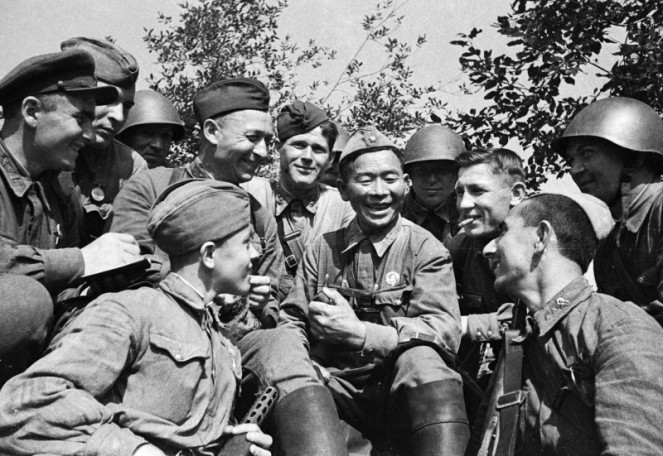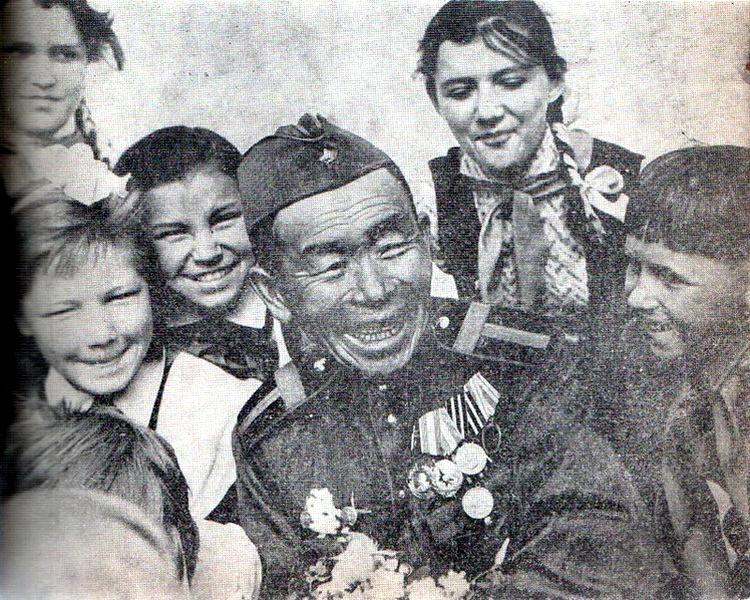
His full Russian name was ‘Semyon Danilovich Nomokonov’ (Семён Дани́лович Номоко́нов), and was of the ‘Evenk-Hamnigan’ ethnicity prevalent within the Siberian area of Russia (this designation refers to Siberian Evenk people who have historically inter-mixed with people of the Mongolian ethnicity). He was born on August 12th, 1900 in Delyun village (now in Sretensky area of the Trans-Baikal Territory), and brought up as an indigenous hunter. The Evenk people are traditionally nomadic reindeer herders, and are thought to be genetically related to certain Korean and Chinese populations. (In my own Chinese-British family in the UK of Hakka (Hong Kong) ethnicity, a prominent Hakka female mDNA line has been traced to the Evenk population of Siberia. This means that certain Hakka clans – living in Southern China – are directly related to the Evenk people thousands of miles away in Siberia). As usual, the Western (English) Wikipedia page referring to this extraordinary Red Army Sniper, is deficient and incorrect, and at variance with Russian language sources. For instance, entirely omitted is Semyon Nomokonov’s military service during the Soviet-Japanese war (1938-1939), where he killed 8 soldiers (and officers) of the Japanese Kwantung Army.

During the Great Patriotic War (1941-1945), Semyon Nomokonov is accredited with killing 360 Nazi German soldiers and officers (including one major-general), bringing his lifetime tally as a sniper to 368 (the English Wikipedia page states that his Soviet military tally was 367). The rifle he used throughout his military career was the 1891 Mosin–Nagant model infantry rifle, which used a five-shot, bolt-loading, internal magazine–fed weapon action, developed by the Imperial Russian Army between 1882 to 1891. Snipers often prefer a bolt-action rifle (even today), as the relay of the new round into the chamber does not include the ‘jump’ associated with many modern semi and full automatic weapons. When calmly sniping from a distance, the soldier remains in control of the entire process, without the rifle ‘moving’ unexpectedly and causing the shot to miss.

This was the rifle Semyon Nomokonov used during the Russo-Japanese War, and which he retained during the Great Patriotic War. Unlike other snipers in the Red Army, Semyon Nomokonov made all his ‘kills’ over long distance without the aid of a telescopic sight. This earned him the sharp-shooter name of ‘Hawk Eye’ (Глаз коршуна – Glaz korshuna). At the out-break of the Great Patriotic War, Semyon Nomokonov, (probably due to his age – he was 41 years old at the time), was a Medic in the Red Army. During that war, the Soviet Armed Forces (as well as the civilian population), suffered millions of causalities, and there were many wounded to tend to after each battle. According to Timur Lambaev’s 2007 book entitled ‘Storm of the Fascist Scum’ (Фашистской нечисти гроза), one day, Semyon Nomokonov was tending to the wounded (on the Kalinin Front) when he saw a Nazi German soldier deliberately targeting the Soviet wounded lying on the ground. Semyon Nomokonov instinctively raised his simple (and old) bolt-loading rifle and fired. Despite the long distance, the shot hit the Nazi German in the centre of the fore-head. This was remarkable considering that Semyon Nomokonov did not make use of a modern telescopic sight. When this incident was reported to the Soviet Authorities, Semyon Nomokonov was immediately transferred to an active-duty sniper platoon.

Those who observed Semyon Nomokonov in action, recorded that when confronting the enemy he became absolutely ‘still’ in both body and mind (as if ‘disappearing’ from obvious sight by becoming ‘one’ with nature). Typically, Semyon Nomokonov hit targets at around 300m to 500m, but on at least one occasion, he hit his target at a recorded 1000m. He wore indigenous hunting clothing of bits of rope and string hanging from his uniform (similar to the ‘gillie’ suit developed in Scotland to camouflage Game-Keepers when watching-out for poachers – now used universally by modern snipers). He wore horse-hair shoes that made very little noise, and reports suggest he made use of irregular-shaped shards of mirror to spy on the enemy without revealing his position. This is peculiar as modern snipers tend to avoid all reflective surfaces for exactly the reason that reflective light gives away even a well-hidden position. However, in the case of Semyon Nomokonov particular expertise, this habit never compromised his position and aided to his success. He used the reflective surface to lure the Nazi Germans to open-fire – and thereby reveal their positions (and usually be instantly killed in return fire). He also made ample use of placing a Red Army helmet on a stick – using it as a puppet to draw enemy fire. No one in his military Unit could equal his ability to conceal and camouflage. Soviet Military Records confirm that throughout his military career serving in the 221st Infantry Division, Semyon Nomokonov killed 638 enemies of Socialism. The Nazi Germans referred to him as ‘Taiga Shaman’ (Таёжный шаман) which appears to translate as something like ‘Spirit of the Tree-Line’. He was wounded eight times in active combat, and received two concussions. For his bravery, he received the following medals; Order of the Red Star (twice), Order of the Red Banner, and the Order of Lenin.

When he retired from the Red Army, he quietly returned to his village in Siberia to resume his simple life – but due to the continuous newspaper, magazine and filmed news articles about his sniping exploits, he became very famous throughout the Soviet Union and was always invited to various schools, colleges and universities to give talks, as well as to political activities. As he supported the October Revolution, he eventually relocated to a Collective Farm named after Lenin – and enjoyed the adulation he received. Not only did thousands of people write to him every week, but once he received a letter from a grieving German woman who asked whether he was the Soviet Sniper who smoked a pipe whilst on the front-line? She further stated that she thought her son – a Nazi German soldier named Gustav Ehrlich – may have been killed by Semyon Nomokonov. She asked whether he had any conscience regarding the hundreds of Germans he had killed? Semyon Nomokonov dictated a letter of reply via his son, and stated that he did indeed smoke a pipe whilst on active duty, and could well have killed her son- but added that if the lady in question had seen the devastation and atrocities committed by the Nazi German Army (particularly in Leningrad, for example), she would not be so quick to judge him, and would curse those who acted like this in her name. He died peacefully on July 15th, 1973.
©opyright: Adrian Chan-Wyles (ShiDaDao) 2017.
English Language Reference: (Deficient)
https://en.wikipedia.org/wiki/Semyon_Nomokonov
Russian Language References: (Complete)

1 comments